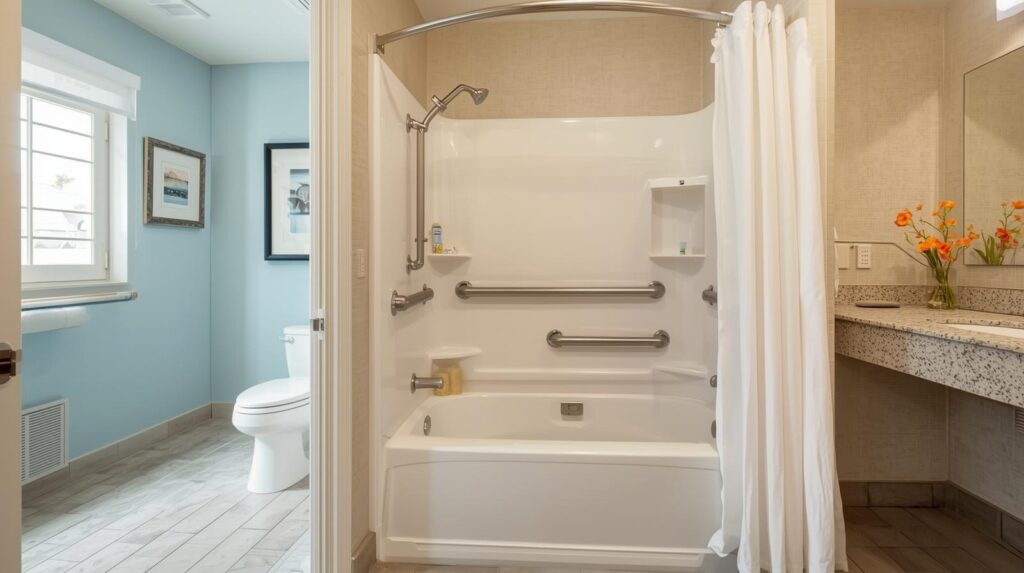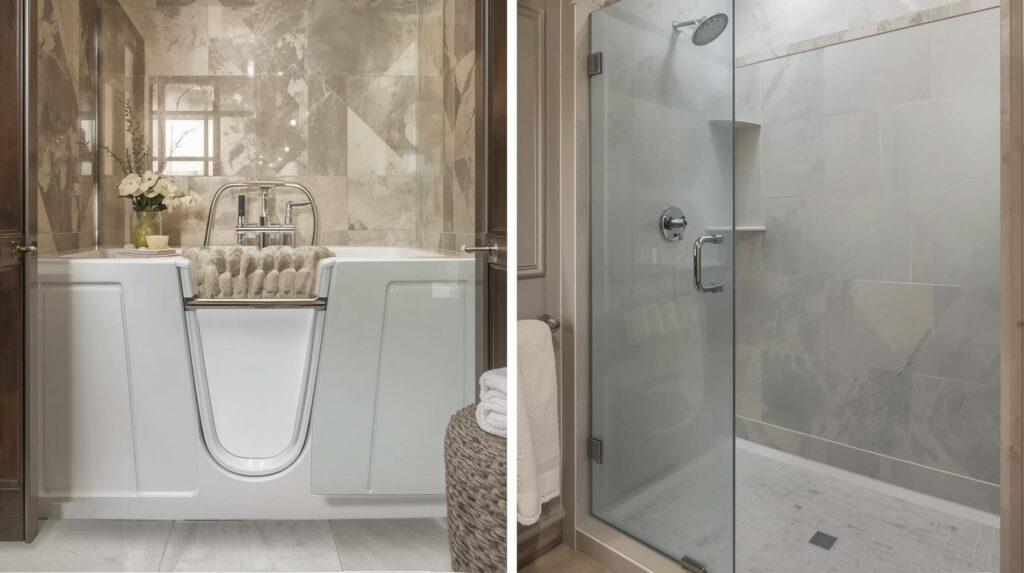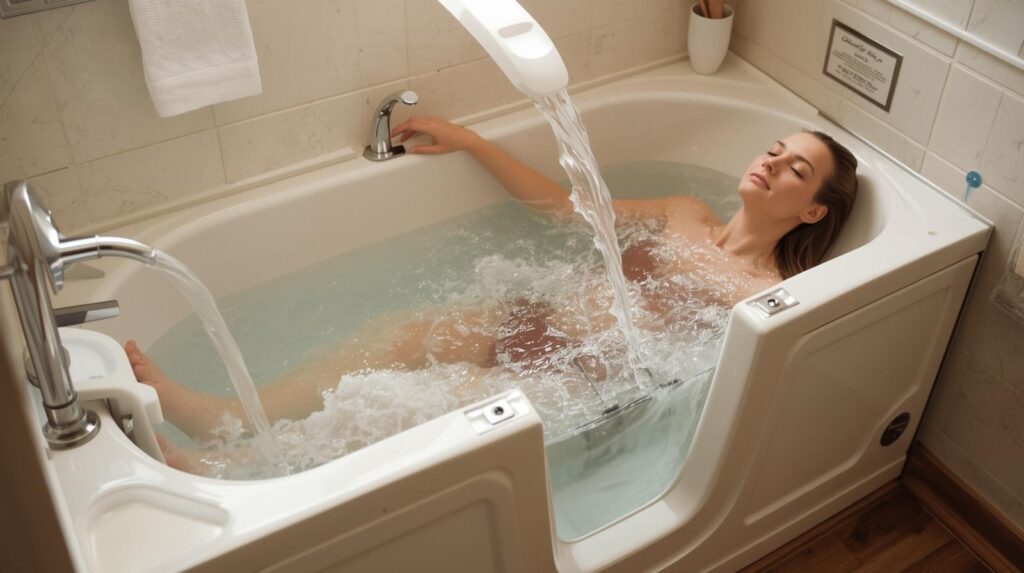
For a senior, the bathroom is a paradox. It’s a space for privacy and independence, but it’s also—statistically—the most dangerous room in the house.
The fear of a fall is real and valid. According to the CDC (Centers for Disease Control), millions of seniors are treated in emergency rooms for fall-related injuries every year, and a staggering number of these falls occur in the bathroom.
But fear doesn’t have to mean a loss of independence. The first step to building a safer, more confident life is to know exactly where the risks are.
Key Takeaways
- The Problem is Real: The combination of hard surfaces, water, and balance challenges makes the bathroom the #1 location for falls.
- The #1 Danger: The high wall of a traditional bathtub is the single greatest risk, requiring strength and balance to overcome.
- Use Our Checklist: We’ve created a simple audit tool you can use right now to find the danger spots in your own bathroom.
- The Goal is Independence: These fixes are not about “getting old”; they are about maintaining your independence safely and confidently.
Your 10-Point Bathroom Safety Audit (A Checklist You Can Use Today)
Take this checklist into your bathroom. Answering “No” to any of these questions reveals a potential safety hazard.
- [ ] 1. The Tub/Shower: Do I have to lift my leg higher than 6 inches to get in?
- [ ] 2. Grab Bars: Do I have professionally installed grab bars (not a towel rack) near the tub AND the toilet?
- [ ] 3. The Floor: Are my floor mats 100% rubber-backed? Do I have a non-slip mat inside the shower/tub?
- [ ] 4. The Toilet: Is the toilet seat low? Do I use the sink or a towel rack to pull myself up?
- [ ] 5. Lighting: Is the room brightly lit, especially the path from the door to the toilet?
- [ ] 6. Thresholds: Do I have to step over a threshold to enter the bathroom?
- [ ] 7. Reach: Can I reach my soap, shampoo, and towel without stretching or bending awkwardly?
- [ ] 8. Water Temp: Is my water heater set to 120°F or lower to prevent scalding?
- [ ] 9. Electrical: Are all electrical outlets GFCI-protected (with the “test/reset” buttons)?
- [ ] 10. Doorway: Is the doorway wide enough for a walker if one is ever needed?
If you answered “No” to several of these, don’t worry. Let’s walk through the most critical fixes right now.
Danger Spot #1: The High Tub Wall
The Problem: This is, without a doubt, the most dangerous spot. A standard bathtub has a 15- to 20-inch wall. Stepping over this ledge requires you to stand on one foot on a potentially damp surface, lift the other leg high, and maintain perfect balance. For anyone with a bit of stiffness, knee pain, or a moment of unsteadiness, this single action is a major fall risk.
The Fixes:
- Good (The Basic Fix): Install multiple, professionally-anchored grab bars on the wall. Add a shower chair so you can sit while in the tub and high-quality non-slip mats both inside and outside the tub.
- Better (The Remodel Fix): You can remodel the area into a “zero-threshold” or “low-barrier” shower, which removes the high wall. This is a good option but can be a long, messy, and expensive construction project.
- Best (The 1-Day Fix): Install a Walk-In Tub. This is the ultimate solution because it completely removes the hazard. The door swings open, allowing you to walk in over a tiny 3- to 4-inch step. You sit down on a built-in, chair-height seat, and then fill the tub. There is zero climbing and zero risk of falling from a height.

Danger Spot #2: The Slippery Floor
The Problem: Ceramic tile is the most common bathroom flooring, and when it gets wet from shower mist or splashes, it becomes as slick as ice. A simple misstep when reaching for a towel or walking to the sink can be disastrous.
The Fixes:
- Good (The Basic Fix): Use high-quality non-slip bath mats with a 100% rubber backing (a simple “throw rug” is not safe and will slide). Most importantly, get in the habit of wiping up any spill or splash immediately.
- Better (The Pro Fix): During a remodel, install high-traction, non-slip tile. Look for tiles with a “DCOF” (Dynamic Coefficient of Friction) rating of .42 or higher, which are designed for wet areas.
Danger Spot #3: Getting On and Off the Toilet
The Problem: This is a hidden danger. A standard toilet is only 14-15 inches high. For a senior—especially one with hip, back, or knee arthritis—squatting down that low and then standing back up requires a huge amount of lower-body strength. It’s a common place to lose your balance and topple over.
The Fixes:
- Good (The Basic Fix): A “raised toilet seat.” This is an inexpensive device that locks onto your existing toilet bowl and adds 3 to 5 inches of height, making it much easier to sit and stand.
- Better (The Pro Fix): Install a new, ADA-compliant “comfort height” toilet. These are permanently 2-3 inches taller than standard toilets and are a more stable, long-term solution.
- Best (The Support Fix): Install a sturdy, wall-mounted grab bar or a toilet safety frame that provides two stable handles to use for leverage as you sit and stand.
How to Talk to a Stubborn Parent About Bathroom Safety
This is for the adult children and caregivers. What if you see the danger, but your parent says, “I’m fine!” This is a common and frustrating challenge.
- Don’t say: “Mom, your bathroom is dangerous and you’re going to fall.” (This feels like an attack on their independence).
- Do say: “Mom, I love you, and I would be devastated if you got hurt. Can we look at some simple ways to make the bathroom safer, so we never have to worry? Your independence is the most important thing to me.”
Focus on the benefit, not just the risk. Instead of “You’re going to fall,” try, “I was reading that a walk-in tub would feel amazing on your arthritis.”
Frequently Asked Questions (FAQ)
1. What is the single most important safety feature to add to a bathroom? Professionally installed grab bars are the #1 most effective addition. They are a non-negotiable must-have. However, the #1 most effective fix is to remove the hazard entirely by replacing a high-wall tub with a walk-in tub or low-threshold shower.
2. Are walk-in tubs really safe? I’m worried about the door leaking or waiting in the cold. This is a very common concern. Modern walk-in tubs are extremely safe. High-quality doors use triple-seal technology and a lifetime warranty to ensure they do not leak. To solve the “waiting” problem, look for models with “fast-fill” and “fast-drain” technology, which can fill or empty the tub in just a couple of minutes.
3. How much do all these safety fixes cost? It varies. The “Good” fixes (grab bars, non-slip mats, raised toilet seats) are very affordable, often under $200 for all of them. A major remodel or the installation of a high-quality walk-in tub is a larger investment.
Your Plan for Independence
Your bathroom doesn’t have to be a source of anxiety. You can reclaim this space by making a few smart, targeted fixes.
If you’re ready to learn more about how a walk-in tub can remove the #1 risk and give you back your bathing independence, we’re here to help.
Get a free, no-obligation quote to learn about your walk-in tub options today.




